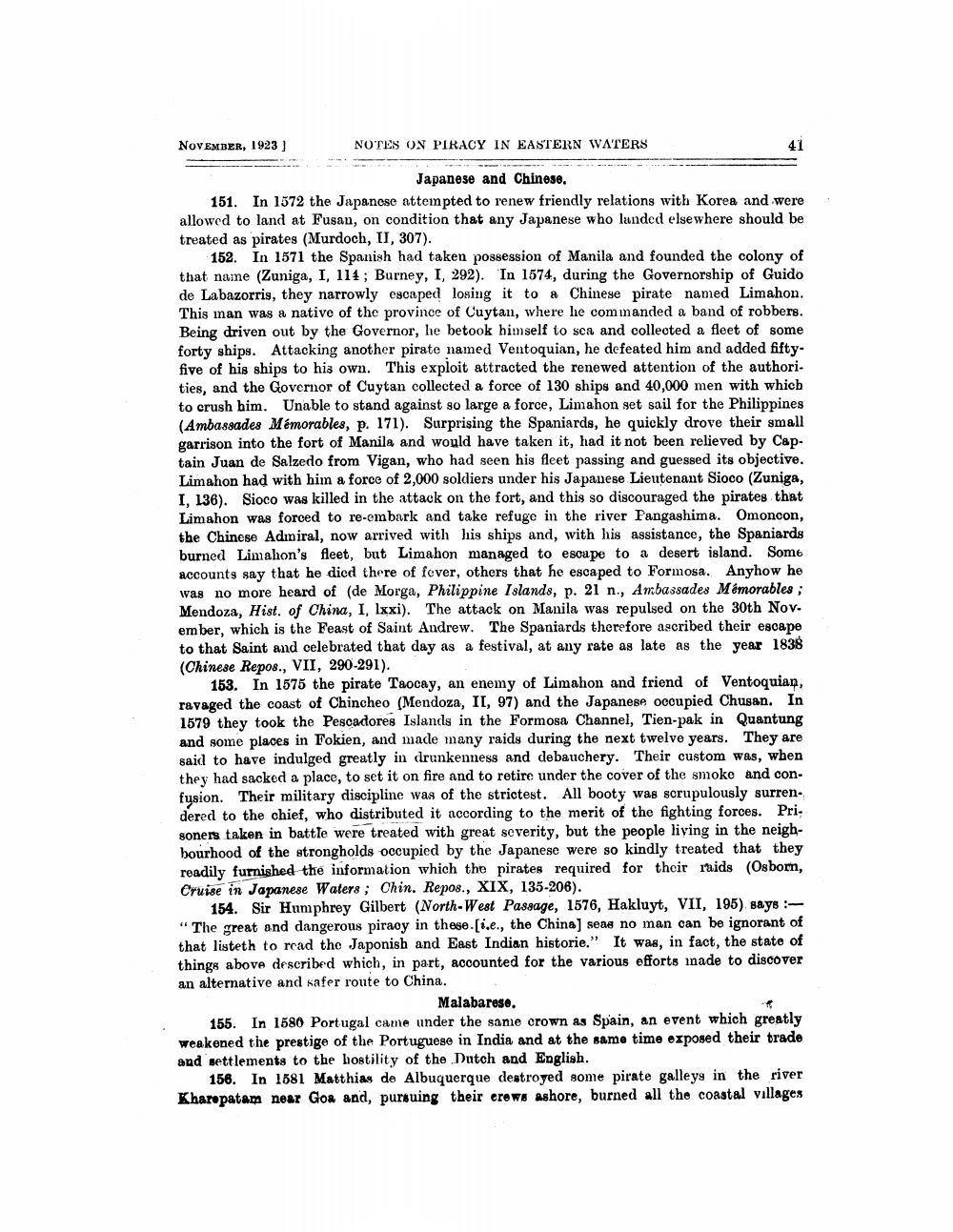________________
NOVEMBER, 1923 ]
NOTES ON PIRACY IN EASTERN WATERS
Japanese and Chinese.
151. In 1572 the Japanese attempted to renew friendly relations with Korea and were allowed to land at Fusan, on condition that any Japanese who landed elsewhere should be treated as pirates (Murdoch, II, 307).
152. In 1571 the Spanish had taken possession of Manila and founded the colony of that name (Zuniga, I, 114; Burney, I, 292). In 1574, during the Governorship of Guido de Labazorris, they narrowly escaped losing it to a Chinese pirate named Limahon. This man was a native of the province of Cuytan, where he commanded a band of robbers. Being driven out by the Governor, he betook himself to sea and collected a fleet of some forty ships. Attacking another pirate named Ventoquian, he defeated him and added fiftyfive of his ships to his own. This exploit attracted the renewed attention of the authori ties, and the Governor of Cuytan collected a force of 130 ships and 40,000 men with which to crush him. Unable to stand against so large a force, Limahon set sail for the Philippines (Ambassades Mémorables, p. 171). Surprising the Spaniards, he quickly drove their small garrison into the fort of Manila and would have taken it, had it not been relieved by Captain Juan de Salzedo from Vigan, who had seen his fleet passing and guessed its objective. Limahon had with him a force of 2,000 soldiers under his Japanese Lieutenant Sioco (Zuniga, I, 136). Sioco was killed in the attack on the fort, and this so discouraged the pirates that Limahon was forced to re-embark and take refuge in the river Fangashima. Omoncon, the Chinese Admiral, now arrived with his ships and, with his assistance, the Spaniards burned Limahon's fleet, but Limahon managed to escape to a desert island. Some accounts say that he died there of fever, others that he escaped to Formosa. Anyhow he was no more heard of (de Morga, Philippine Islands, p. 21 n., Ambassades Mémorables; Mendoza, Hist. of China, I, lxxi). The attack on Manila was repulsed on the 30th Nov. ember, which is the Feast of Saint Andrew. The Spaniards therefore ascribed their escape to that Saint and celebrated that day as a festival, at any rate as late as the year 1838 (Chinese Repos., VII, 290-291).
153. In 1575 the pirate Taocay, an enemy of Limahon and friend of Ventoquian, ravaged the coast of Chincheo (Mendoza, II, 97) and the Japanese occupied Chusan. In 1579 they took the Pescadores Islands in the Formosa Channel, Tien-pak in Quantung and some places in Fokien, and made many raids during the next twelve years. They are said to have indulged greatly in drunkenness and debauchery. Their custom was, when they had sacked a place, to set it on fire and to retire under the cover of the smoke and confusion. Their military discipline was of the strictest. All booty was scrupulously surren dered to the chief, who distributed it according to the merit of the fighting forces. Prisoners taken in battle were treated with great severity, but the people living in the neighbourhood of the strongholds occupied by the Japanese were so kindly treated that they readily furnished the information which the pirates required for their raids (Osborn, Cruise in Japanese Waters; Chin. Repos., XIX, 135-206).
41
154. Sir Humphrey Gilbert (North-West Passage, 1576, Hakluyt, VII, 195) says:"The great and dangerous piracy in these.[i.e., the China] seas no man can be ignorant of that listeth to read the Japonish and East Indian historie." It was, in fact, the state of things above described which, in part, accounted for the various efforts made to discover an alternative and safer route to China.
Malabarese.
155. In 1580 Portugal came under the same crown as Spain, an event which greatly weakened the prestige of the Portuguese in India and at the same time exposed their trade and settlements to the hostility of the Dutch and English.
156. In 1581 Matthias de Albuquerque destroyed some pirate galleys in the river Kharopatam near Goa and, pursuing their crews ashore, burned all the coastal villages




